ESP AUDI TT 2013 Owner´s Manual
[x] Cancel search | Manufacturer: AUDI, Model Year: 2013, Model line: TT, Model: AUDI TT 2013Pages: 262, PDF Size: 65.91 MB
Page 80 of 262
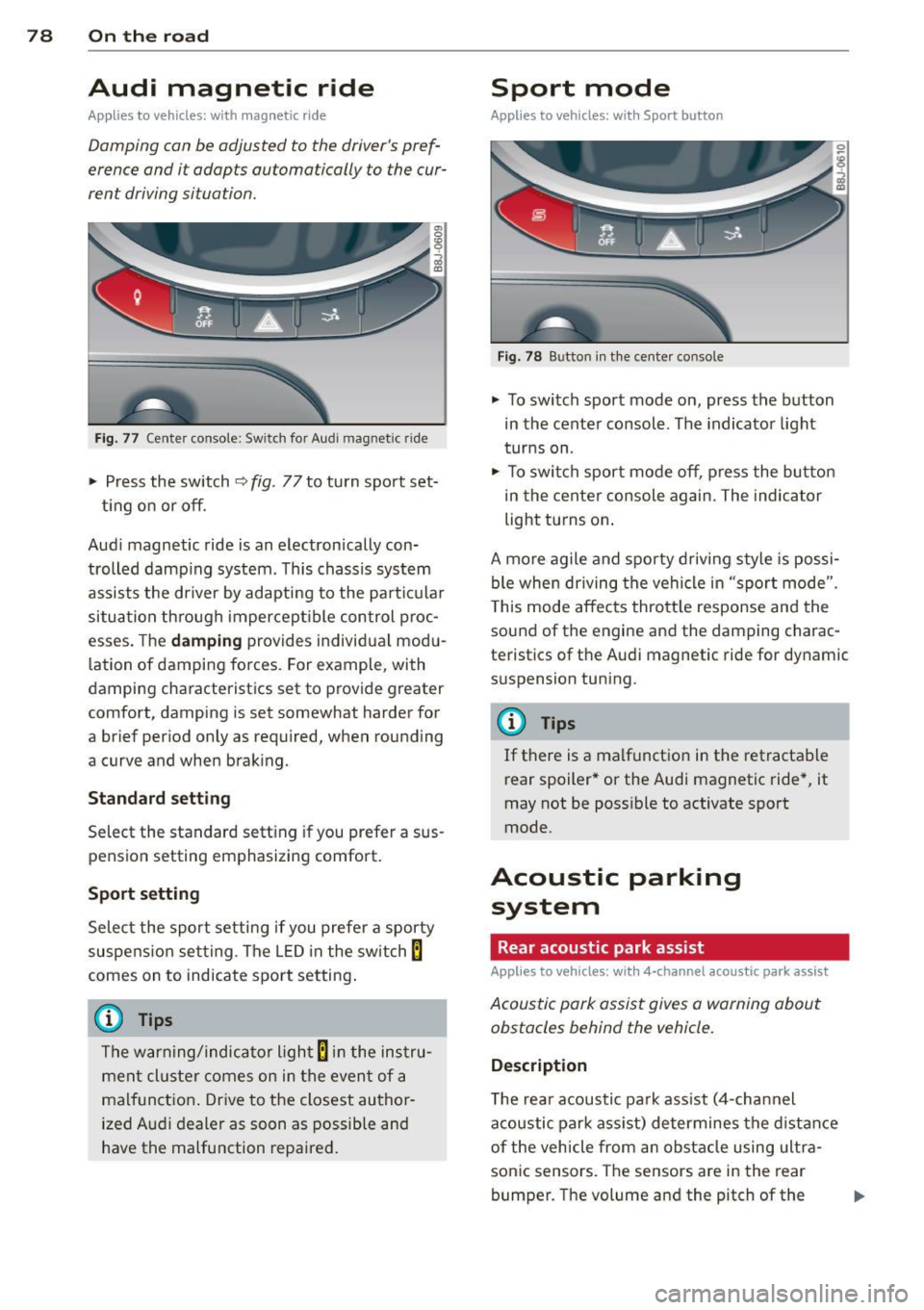
78 On the road
Audi magnetic ride
Applies to vehicles: with mag netic r ide
Damping can be adjusted to the driver's pref
erence and it adapts automatically to the cur
rent driving situation.
Fig. 77 Cente r console: Switch for Audi magnetic r ide
.,. Press the switch ~ fig . 77 to turn spo rt set-
t ing o n or off.
Aud i magnetic ride is an electron ically con
trolled damp ing system . Th is chassis system
assists the driver by adapting to the par ticular
situatio n th rough imper cep tible con trol p roc
esses. The
damping provides individual mod u
l ation of damping forces. For example, with
dampi ng cha racterist ics set to p rovide greater
comfort, damping is set somewhat harder for
a brief period only as required, when rounding
a curve and when braking.
Standard setting
Select the standard sett ing if you prefer a sus
pension setting emphasizing comfort.
Sport setting
Select the sport setti ng if you prefe r a sporty
suspe nsio n setting . The LED in the sw itch
8
comes on to indicate spo rt setting .
@ Tips
The w arning/indicator light 8 in the in stru
ment cluster comes on in the even t of a
malfunction . Drive to the closest au thor
ized Audi dealer as soon as possible and
have the malfunction repaired.
Sport mode
Applies to vehicles: wit h Sport but ton
F ig . 7 8 Button in th e ce nte r console
.,. To switch sport mode on, press the button
in th e cente r console. The indicator light
t ur ns on .
.,. To swi tch spor t mo de off, press the bu tto n
in the center co nsole again. The indicator
light turns on .
A mo re agile and spo rty d riv in g style is po ssi
ble when driving the vehicle in "sport mode".
T his mode affec ts thrott le response and the
sound of the engine and the damping charac
teristics of the Audi magnetic ride for dynamic
s uspension tuning .
@ Tips
If there is a malfunct ion in the retracta ble
rear spoiler* or the Audi magnetic ride*, it
may not be poss ible to activate sport
mode.
Acoustic parking system
Rear acoustic park assist
Applies to vehicles: wit h 4-channel acoustic park assist
Acous tic park assist gives a warning about
obstacles behind the vehicle.
Description
T he rea r acousti c park ass ist (4-cha nnel
a coustic park ass ist) determines the distance
of the vehicle from an obstacle using ultra
son ic sensors. The sensors are in the rear
bumper. The volume a nd the pitch of the
Page 93 of 262

.. Fasten your safety belt and wear it properly.
Also instruct your passengers to fasten their
safety belts properly ¢
page 100.
What impairs driving safety?
Safe driving is directly related to the condi
tion of the vehicle, the driver as well as the
driver's ability to concentrate on the road
without being distracted.
The driver is responsible for the safety of the
veh icle and a ll of its occupants . If your ability
to drive is impaired, safety risks for everybody
in the vehicle increase and you also become a
hazard to everyone else on the road ¢
,&..
Therefore:
.. Do not let yourself be distracted by passen
gers or by us ing a cellular telephone.
.. NEVER drive when your driv ing ability is im
paired (by medicat ions, alcohol, drugs, etc .) .
.. Observe all traffic laws, rules of the road
and speed limits and plain common sense.
.. ALWAYS adjust your speed to road, traffic
and weather condit ions .
.. Take frequent breaks on long trips . Do not
drive for more than two hours at a stretch .
.. Do NOT drive when you are tired, under
pressure or when you are stressed.
A WARNING
Impaired driving safety increases the risk
of serious personal injury and death when
ever a vehicle is being used .
Driving Safely 91
Proper occupant
seating positions
Proper seating position for the driver
The proper driver seating position is impor
tant for safe, relaxed driving.
Fig. 91 The correct d istance between d river a nd stee r
in g whee l
For your own safety and to reduce the risk of
injury in the event of an accident, we recom
mend that you adjust the driver's seat to the
foll owing pos ition:
.,. Adjust the driver's seat so that you can easi
ly push the pedals all the way to the floor
while keeping your knee(s) slightly bent
q&_ ,
.. Adjust the angle of the seatback so that it is
in an upright position so that your back
comes in full contact with it when you drive.
.. Adjust the steering wheel so that there is a
distance of at least 10 inches (25 cm) be
tween the steering wheel and your breast
bone ¢
fig. 91. If not possible, see your au
thorized Audi dealership about adaptive
equ ipment .
.. Adjust the steer ing wheel so that the steer
ing wheel and airbag cover points at your
chest and not at your face .
.. Grasp the top of the steering wheel with
your elbow(s) slightly bent .
.. Adjust the head restraint so the upper edge
is as even as possible with the top of your
head . If that is not poss ible, try to adjust
the head restraint so that it is as close to
this position as possible .
.. Fasten and wear safety belts correctly
qpage 104.
Page 96 of 262
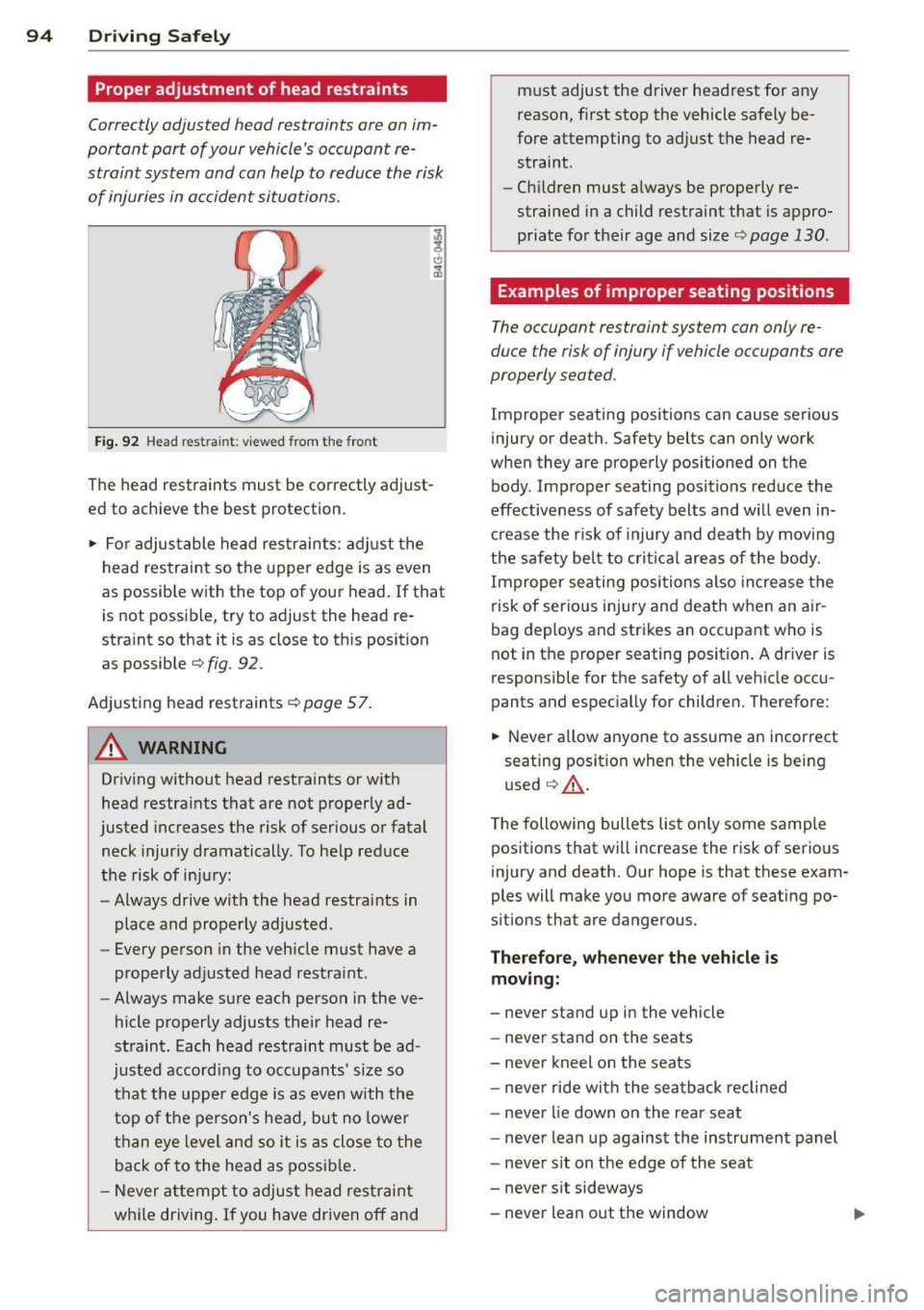
94 Driving Safel y
Proper adjustment of head restraints
Correctly adjusted head restraints are an im
portant part of your vehicle's occupant re
straint system and can help to reduce the risk of injuries in accident situations.
Fig. 92 Head restra int : viewed from t he fro nt
The head restraints must be correctly adjust
ed to achieve the best protection.
~ For adjustable head restraints: adjust the
head restraint so the upper edge is as even
as possible with the top of your head. If that is not possible, try to adjust the head re
straint so that it is as close to this position as possible
r:::> fig. 92 .
Adjusting head restraints r:::> page 57.
&_ WARNING
Driving without head restraints or with
head restraints that are not properly ad
justed increases the risk of serious or fatal
neck injuriy dramatically. To help reduce
the risk of injury:
- Always drive with the head restra ints in
place and properly adjusted.
- Every person in the vehicle must have a
properly adjusted head restraint.
- Always make sure each person in the ve
hicle properly adjusts their head re
straint. Each head restraint must be ad
justed according to occupants' size so
that the upper edge is as even w ith the
top of the person's head, but no lower
th an eye level and so it is as close to the
back of to the head as possible.
- Never attempt to adjust head restraint
wh ile driving. If you have driven
off and must adjust the driver headrest for any
reason, first stop the vehicle safely be
fore attempting to adjust the head re straint .
- Ch ildren must always be properly re
strained in a child restraint that is appro
priate for their age and size
c:> page 130.
· Examples of improper seating positions
The occupant restraint system can only re
duce the risk of injury if vehicle occupants are
properly seated .
Improper seating positions can cause serious
injury or death. Safety belts can only work
when they are properly positioned on the body . Improper seating positions reduce the
effectiveness of safety belts and will even in
crease the risk of injury and death by moving
the safety belt to critical areas of the body.
Improper seating posi tions also increase the
risk of serious injury and death when an air
bag deploys and strikes an occupant who is
not in the proper seating position . A dr iver is
responsible for the safety of all vehicle occu
pants and especially for children. Therefore :
~ Never allow anyone to assume an incorrect
seating position when the vehicle is being
used
c::> _& .
The following bullets list only some sample
positions that will increase the risk of serious
injury and death. Our hope is that these exam
ples will make you more aware of seating po
sitions that are dangerous.
Therefore , whenever the vehicle is
moving:
- never stand up in the vehicle
- never stand on the seats
- never kneel on the seats
- never ride with the seatback reclined
- never lie down on the rear seat
- never lean up against the instrument panel
- never s it on the edge of the seat
- never sit sideways
- never lean out the window
Page 99 of 262

A WARNING ,~
Heavy loads will influence the way your ve
hicle handles. To help reduce the r isk of a
loss of control leading to ser ious personal
injury:
-Always keep in m ind when transporting
heavy objects, that a change in the cen
ter of g ravity can also cause changes in
vehicle handling:
- Always distribute the load as even ly as
possible.
- Place heavy objects as far forward in
the luggage compartment as possible.
- Never exceed the Gross Ax le Weight Rat
ing or the Gross Vehicle Weight Rating
specified on the safety compliance stick
er on the left door jamb. Exceeding per missible we ight standards can cause the
vehicle to slide and handle differently .
- Please observe information on safe driv
ing
i:> page 90.
A WARNING
To help prevent poisonous exhaust gas
from be ing drawn into the veh icle, always
keep the rear lid closed while dr iving.
- Never transport objects larger than those fitting completely into the luggage
area because the rear lid cannot be fully
cl osed.
- If you absolutely must drive with the rear
lid open, observe the follow ing notes to
reduce the risk of poisoning:
- Close all windows,
- Open all air outlets in the instrument
panel,
- Sw itch off the air recircu lation,
- Set the fresh ai r fan to the h ighes t
speed .
A WARNING
Always make sure that the doors, all win
dows and the rear lid are securely closed
and locked to reduce the risk of injury
when the veh icle is not being used.
Dr iving S afel y 97
-After closing the rear lid, always make
sure that it is properly closed and locked.
- Never leave your vehicle unattended es
pecially with the rear lid left open. A
child could crawl into the vehicle through
the luggage compartment and close the
rear lid becoming trapped and unable to
get o ut. Being trapped in a vehicle can
lead to serious personal injury.
- Never let ch ildren play i n or around the
veh icle .
- Never let passengers ride in the luggage
compartment. Vehicle occupants must
always be prope rly restra ined in one of
the vehicle 's seating pos it ions .
(D Tips
- Air circulation helps to reduce window
fogging. Stale a ir escapes to the outside
through vents in the trim panel, on the
left side of the luggage compartment. Be sure to keep these s lots free and
open.
- The tire pressure m ust correspond to the
load. The tire pressure is shown on the
tire pressure label. The tire pressure la
bel is located on the driver's side B-pillar.
The tire pressure label lists the recom
mended co ld tire inflation pressures for
the vehicle at its maximum capacity
we ight and the tires that were on your
vehicle at the t ime it was manufactured .
For recommended tire pressures for nor
ma l load cond itions, please see chapter
i=>page 200.
Tie-downs
The luggage compartment is equipped with
four tie-downs to secure luggage and other
items.
Use the t ie-downs to secure your cargo prop
erly
c> page 96, Loading the luggage com
partment .
In a collision, the laws of physics mean that
even smaller items that are loose in the vehi-
cle w ill become heavy missiles that can cause .,.
•
•
Page 102 of 262
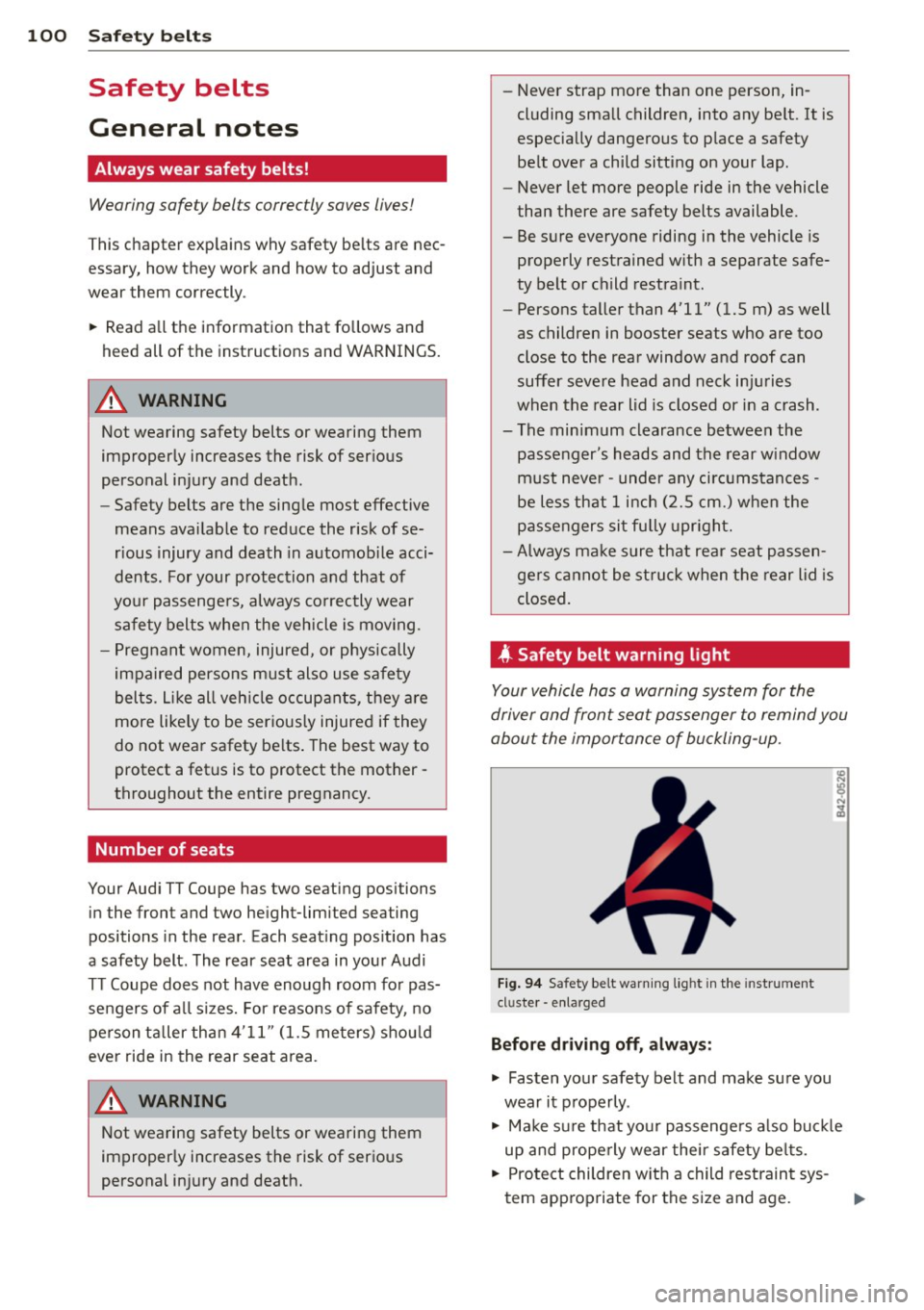
100 Safety belts
Safety belts
General notes
Always wear safety belts!
Wearing safety belts correctly saves lives!
This chapter explains why safety belts are nec
essary, how they work and how to adjust and
wear them correctly .
.. Read all the information that follows and
heed all of the instructions and WARNINGS.
A WARNING
Not wearing safety belts or wearing them
improperly increases the risk of serious
personal injury and death.
- Safety belts are the single most effective
means available to reduce the risk of se
rious injury and death in automobile acci
dents. For your protection and that of
your passengers, always correctly wear
safety belts when the vehicle is moving.
- Pregnant women, injured, or physically
impaired persons must also use safety
belts. Like all vehicle occupants, they are
more likely to be seriously injured if they
do not wear safety belts. The best way to
protect a fetus is to protect the mother -
throughout the entire pregnancy.
Number of seats
Your Audi TT Coupe has two seating positions in the front and two height-limited seating
positions in the rear. Each seating position has
a safety belt. The rear seat area in your Audi
TT Coupe does not have enough room for pas
sengers of all sizes. For reasons of safety, no
person taller than 4'11" (1.S meters) should
ever ride in the rear seat area.
A WARNING
Not wearing safety belts or wearing them
improperly increases the risk of serious
personal injury and death. -
Never strap more than one person, in
cluding small children, into any belt.
It is
especially dangerous to place a safety belt over a child sitting on your lap.
- Never let more people ride in the vehicle
than there are safety belts available.
- Be sure everyone riding in the vehicle is
properly restrained with a separate safe
ty belt or child restraint.
- Persons taller than 4'11" (1.5 m) as well
as children in booster seats who are too
close to the rear window and roof can
suffer severe head and neck injuries
when the rear lid is closed or in a crash .
- The minimum clearance between the passenger's heads and the rear window
must never -under any circumstances -
be less that 1 inch (2.5 cm.) when the
passengers sit fully upright.
- Always make sure that rear seat passen
gers cannot be struck when the rear lid is
closed.
,! Safety belt warning light
Your vehicle has a warning system for the
driver and front seat passenger to remind you
about the importance of buckling-up.
Fig. 94 Safety belt warning light in the instrument
cluster· enlarged
Before driving off, always:
" Fasten your safety belt and make sure you
wear it properly .
.. Make sure that your passengers also buckle
up and properly wear their safety belts.
.. Protect children with a child restraint sys-
tem appropriate for the size and age.
Ill-
Page 108 of 262
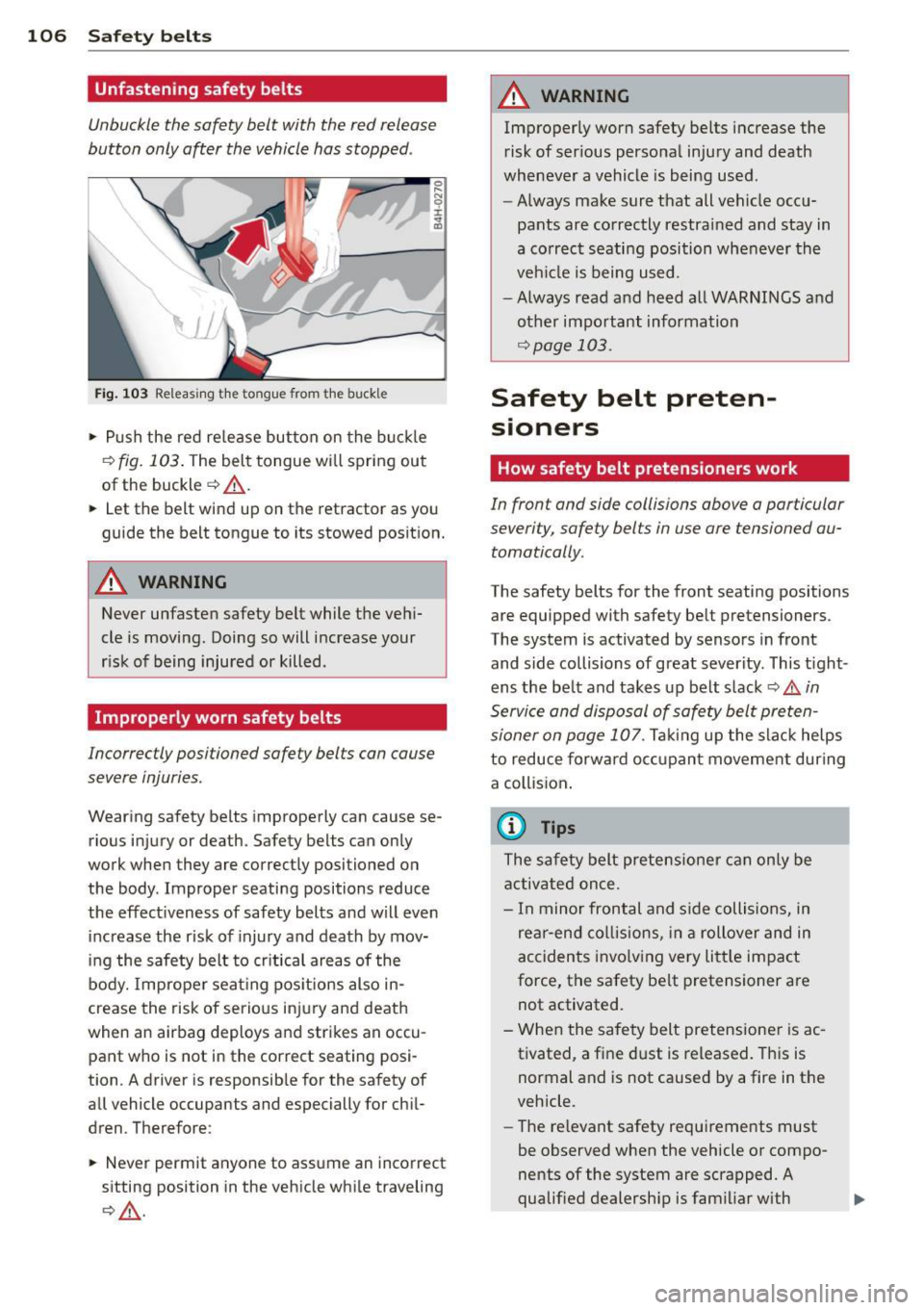
106 Safety belts
Unfastening safety belts
Unbuckle the safety belt with the red release
button only after the vehicle has stopped .
Fig. 103 Releasing the tongue from the buckle
• Push the red release button on the buckle
c> fig. 103. The belt tongue will spring out
of the buckle ~
,A.
0 r-N 0 ±.
"' a,
• Let the belt wind up on the retractor as you
guide the belt tongue to its stowed position.
A WARNING
Never unfasten safety belt while the vehi
cle is moving . Doing so will increase your
r isk of being injured or killed .
Improperly worn safety belts
Incorrectly positioned safety belts can cause
severe injuries.
Wearing safety belts improperly can cause se
rious injury or death. Safety belts can only
work when they are correctly positioned on the body . Improper seating positions reduce
the effectiveness of safety belts and will even
increase the risk of injury and death by mov
ing the safety belt to critical areas of the
body. Improper seating positions also in
crease the risk of serious injury and death
when an airbag deploys and strikes an occu
pant who is not in the correct seating posi
tion . A driver is responsible for the safety of
all vehicle occupants and especially for chil
dren. Therefore:
• Never permit anyone to assume an incorrect
sitting position in the vehicle while traveling
c>,&. .
A WARNING
-Improperly worn safety belts increase the
risk of ser ious personal injury and death
whenever a vehicle is being used.
- Always make sure that all vehicle occu
pants are correctly restrained and stay in
a correct seating position whenever the
veh icle is being used.
- Always read and heed all WARNINGS and
other important information
~ page 103.
Safety belt preten
sioners
How safety belt pretensioners work
In front and side collisions above a particular
severity, safety belts in use are tensioned au
tomatically .
The safety belts for the front seating positions
are equipped with safety belt pretensioners .
The system is activated by sensors in front
and side collisions of great severity. This tight
ens the belt and takes up belt slack
c> .&. in
Service and disposal of safety belt preten
sioner on page 107.
Taking up the slack helps
to reduce forward occupant movement during
a collision.
(D Tips
The safety belt pretensioner can only be
activated once .
- In minor frontal and side collisions, in
rear -end collisions, in a rollover and in
accidents involving very little impact
force, the safety belt pretensioner are
not activated.
- When the safety belt pretensioner is ac
tivated, a fine dust is released. This is normal and is not caused by a fire in the
vehicle.
- The relevant safety requirements must
be observed when the vehicle or compo
nents of the system are scrapped. A
qualified dealership is familiar with
II>
Page 110 of 262

108 Airbag sys tem
Airbag system
Important things to know
Importance of wearing safety belts and
sitting properly
Airbags are only supplemental restraints. For
airbags to do their job , occupants must al
ways properly wear their safety belts and be
in a proper seating position.
F or your safety and the safety of your passen
gers, before driving off, a lways:
• Adjust the dr iver's seat and steering wheel
properly ¢
page 91,
• Adjust the front passenger's seat properly
r=:;page 55,
• Wear safety be lts properly r=; page 103,
• Always properly use the proper child re-
stra int to protect children¢
page 130.
In a collision airbags must inflate within the
blink of an eye and with considerable force .
The supplementa l airbags can cause injuries if
the dr iver or the front seat passenger are not
seated properly . Therefore in order to help the
a irbag to do its job, it is impo rtant, both as a
d river and as a passenge r to s it prope rly at all
times.
By keeping room between your body and the
steering wheel and the front of the passenge r
compa rtment, the airbag can inflate fully and
comp lete ly and provide supp lemental protec
tion in ce rtain frontal collisions
r=:; page 91,
Proper occupant seating positions .
For detai ls
on the operat ion of the seat adjustment con
trols ¢
page 55 and c:, page 56.
It's especially important that children a re
properly restrained ¢
page 130.
There is a lot that the driver and the passen
gers can and must do to help the individua l
safety features installed in your A udi work to
gether as a system.
P rope r seat ing pos ition is important so that
the front airbag on the drive r side can do its
job. If yo u have a physical impa irment or con- dition that prevents yo
u from sitting properly
o n the driver seat with the safety belt properly
fastened and reaching the peda ls, or if you
have concerns with regard to the function or
operation of the Advanced Airbag System,
please contact your author ized Audi dealer or
qualified workshop, o r call Audi Customer Re
lations at 1-800-822-2834 fo r poss ible modi
fica tions to your ve hicle.
When the airbag system dep loys, a gas gener
ator will f il l the a irbags, break open t he pad
ded cove rs, and inflate between t he steering
whee l and the dr ive r and be tween the instru
ment pane l and the fron t passenger. The a ir
bags will deflate immediately after dep loy
me nt so that the front occupants can see
t hr ough the windshie ld again witho ut inter
ruption .
All of th is takes p lace in the b link o f an eye, so
fast that many peop le don't even realize tha t
t h e airbags have deployed. The airbags a lso
inflate with a great dea l of force and nothing
shou ld be in their w ay when they deploy.
Front a irbags in combination with properly
wor n safety belts slow down and lim it the oc
cupant's forward movement . T ogether they
help to prevent the drive r and front seat pas
senger from hitti ng pa rts of the inside the ve
hicle while reducing the forces acting on the
occupant dur ing the crash . In this way they
help to reduce the risk of injury to the head
and upper body in the crash. A irbags do not
protect the arms or the lower parts of the
body.
Both front airbags wi ll not inflate in all fronta l
collisions . The triggering of the airbag system
depends on the vehicle dece lerat ion rate
caused by the co llision and registered by the
electron ic control unit. If th is rate is below
the reference value programmed into the con
t rol unit , the airbags will not be trigge red,
even though the car may be badly damaged as
a res ult of the co llision . Ve hicl e damage, re
pair costs o r even the lack of ve hicle damage
is not necessari ly an indication of whether an
airbag shou ld inflate or not .
IJll-
Page 112 of 262
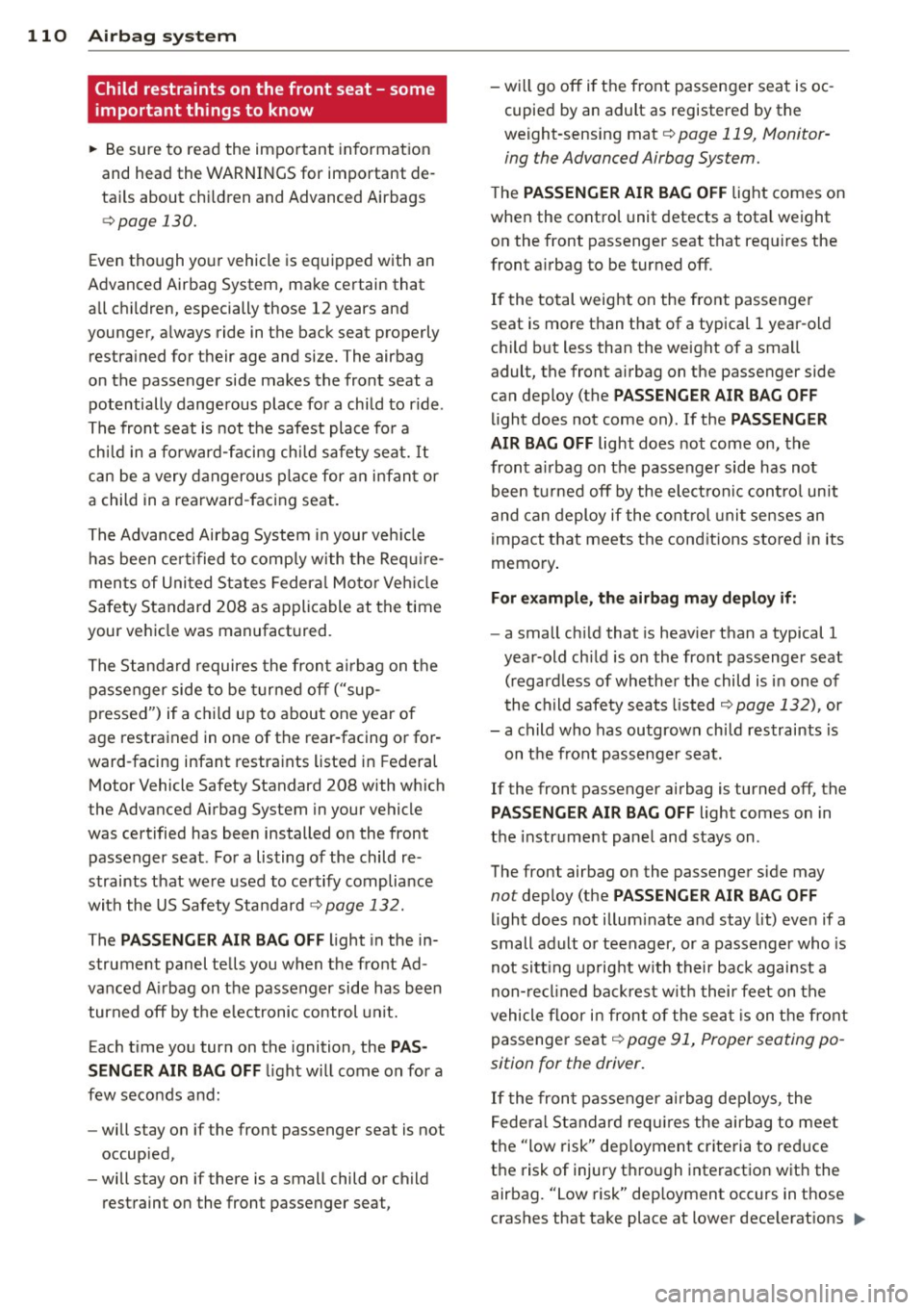
110 Airbag sys te m
Child restraints on the front seat - some
important things to know
• Be sure to read the impo rtant in formation
and head the WARNINGS for important de
ta ils about ch ildren and Advanced Airbags
i=> page 130.
Even though your vehicle is equipped with an
Advanced Airbag System, make certain that
all children, especially those 12 years and
younger, a lways ride in the back seat properly
restra ined for their age and size. The airbag
on the passenger side makes the front seat a potentially dangerous place for a child to r ide .
The front seat is not the safest place fo r a
chi ld in a fo rward-facing chi ld safety seat. It
can be a very dangerous place for a n infan t or
a child in a rearward-facing seat.
The Advanced Airbag System i n your veh icle
has been certified to comply with the Requ ire
men ts of United States Federa l Mo to r Veh icle
Safety Standard 208 as applicable at the time
your vehicle was manufact ured.
The Standa rd requires the fron t air bag on t he
passenger side to be turned off ("sup
p ressed") if a ch ild up to about one yea r of
age restrained in one of the rear-facing or for
ward-facing infant restraints listed in Federal
Motor Vehicle Safety Standard 208 with which
the Advanced A irbag System in your vehicle
was certified has been installed on the front passenger seat . For a listing of the child re
straints that were used to certify compliance
with the US Safety Standard
c> page 132.
The PASSENGE R AIR BAG OFF light in the in
strument panel tells you when the front Ad
vanced A irbag on the passenger side has been
turned off by t he e lectronic control unit.
Each t ime you tur n on the ignition, the
PAS
SENGER AIR BAG OFF
l ight will come on for a
few seconds and:
- will stay on if the front passenger seat is not
occupied ,
- will stay on if there is a small child or child
restraint on the front passenger seat, -
will go off if the front passenger seat is oc
cupied by an adult as registered by the
weight -sensing mat
r::!) page 119, Monitor
ing the Advanced Airbag System.
T he PASSENGER AIR BAG OFF light comes on
when the control unit detects a tota l weight
on the front passenger seat that req uires the
front a irbag to be turned off .
If the total weight on the front passenge r
seat is more than that of a typica l 1 year -old
c h ild b ut less than the weight of a small
adult, the front airbag on the passenger side
can deploy (the
PASSENGER AIR BAG OFF
li ght does not come on). If the PAS SENGER
AIR BAG OFF
light does not come on, the
front a irbag on the passenger side has not
been turned off by the elect ronic con trol unit
and can deploy if the control uni t se nses an
impact that meets the cond itions stored in its
memory .
For exampl e, th e airbag ma y deplo y if:
-a small ch ild that is heav ie r than a typical 1
year-old ch ild is on the front passenger seat
( r egard less of whethe r the child is in one of
the child safety seats listed
<:!) page 132), or
- a child who has outgrown ch ild restraints is
on t he front passenger seat.
If the front passenger airbag is turned off, the
PASSENGER AIR BAG OFF light comes on in
the instrument pane l and stays on .
The front airbag on the passenger side may
not deploy (the PASSENGER AIR BAG OFF
light does not illum inate and stay lit) even if a
small adult o r teenager, or a passenger who is
not sitt ing up rig ht w ith their back against a
non- re cli ned ba ck res t w it h thei r feet on the
vehicle floor in front of the sea t is on the front
passenge r seat
c::> page 91, Proper seating po
sition for the driver.
If the front passenger a irbag dep loys, the
F ede ra l St andard req uires the airbag to meet
the "low risk" dep loyment criteria to reduce
the risk of injury t hro ugh interaction wit h the
airbag. "Low risk" dep loyment occ urs in those
crashes that take place at lower dece lerat ions ..,_
Page 114 of 262
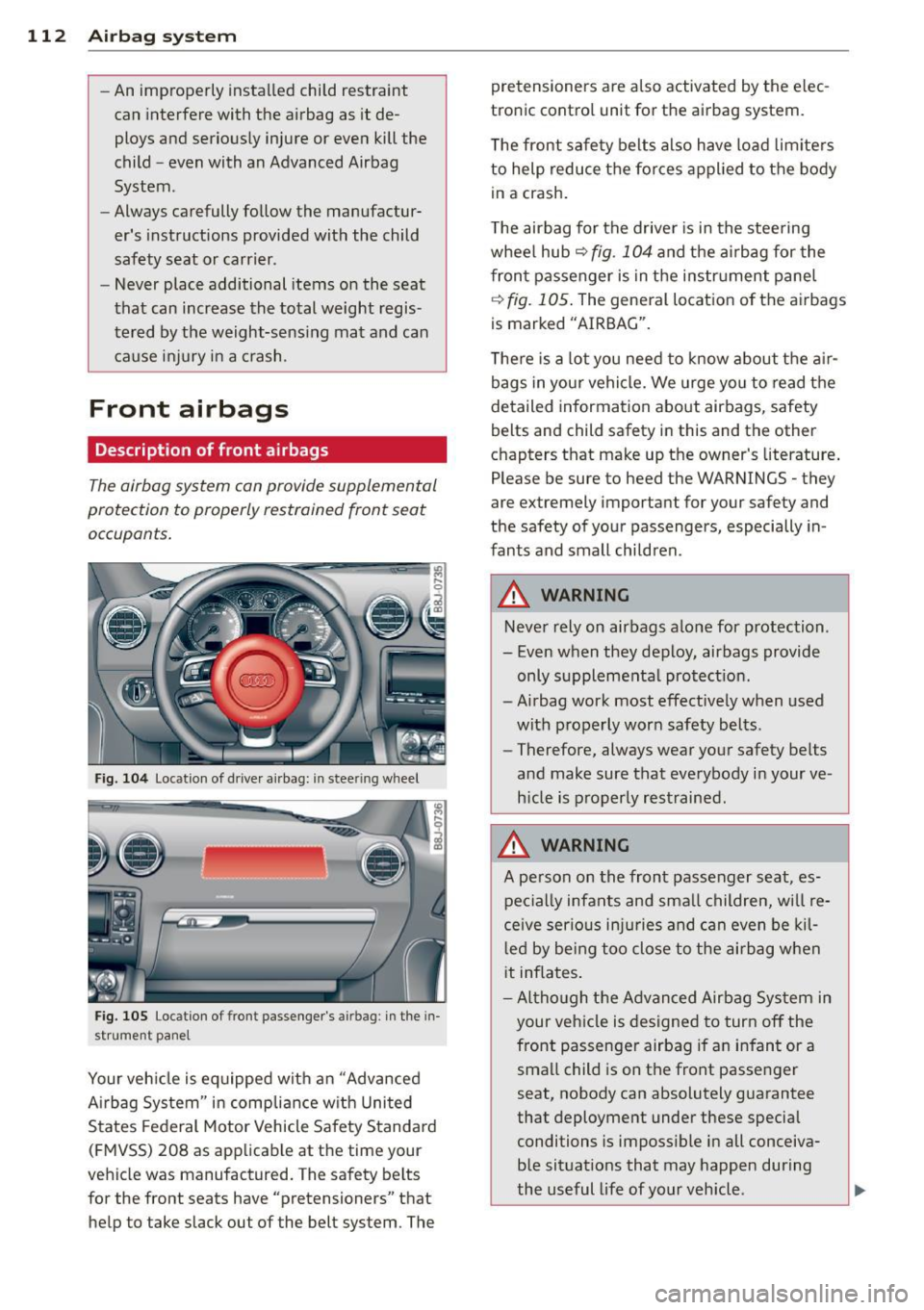
112 Airbag system
-An improperly installed child restraint
can interfere with the airbag as it de
ploys and seriously injure or even kill the
child -even with an Advanced Airbag
System .
- Always carefully follow the manufactur
er's instructions provided with the child
safety seat or carrier.
- Never place additional items on the seat
that can increase the total weight regis tered by the weight-sensing mat and can
cause i njury in a crash .
Front airbags
Description of front airbags
The airbag system con provide supplemental
protection to properly restrained front seat
occupants.
Fig. 104 Location of driver airbag: in stee ring wheel
Fig. 105 Location of front passenger's air bag : in the in
st rume nt panel
Your veh icle is equipped with an "Advanced
A irbag System" in compliance w ith United
States Federal Motor Vehicle Safety Standa rd
(FMVSS) 208 as applicab le at the time your
vehicle was manufactured. The safety belts
for the front seats have "pretensioners" that
help to take slack out of the belt system. The pretensioners are a
lso activated by the e lec
tronic contro l unit for the airbag system.
T he front safety belts also have lo ad lim ite rs
to help reduce the fo rces applied to the body
in a crash .
T he airbag for the d river is in the steering
wheel hub~
fig. 104 and the ai rbag for the
fron t passenger is in the instrument panel
~ fig. 105 . The general locat ion of the ai rbags
is marked "AIRBAG".
T he re is a lot you need to know about t he a ir
bags in you r vehicle. We urge yo u to read the
detailed information abo ut airbags, safety
belts and child safety in this and the other
chapters that make up the owner's literature .
P lease be sure to heed the WARNINGS - they
are extremely important for your safety and
the safety of your passengers, especially in
fants and small children .
A WARNING
Never rely on airbags alo ne for protection .
- Even when they deploy, airbags provide
only supplemental protect ion.
- Airbag work most effective ly when used
with properly worn safety belts.
- Therefore, always wear your safety belts
a nd make sure that eve rybody in your ve
h icle is p roperly rest rained.
A WARNING
A person on the front passenger seat, es
pec ially infants and sma ll children, w ill re
ceive serio us injuries and can even be kil-
l ed by be ing too close to the ai rbag when
i t inflates .
- Al tho ugh the Advanced Airbag System in
your veh icle is designed to tur n
off the
front passenge r airbag if an infant or a
small child is on the front passenger
seat, nobody can absolutely guarantee
that deployment under these special
conditions is impossible in all conceiva
b le situat ions that may happen during
-
the useful life of your vehicle . ~
Page 115 of 262

-The Advanced Airbag System can deploy
in accordance with the "low risk" option
under the U .S . Federal Standard if a child
that is heavier than the typical one-year
old child is on the front passenger seat
and the other conditions for airbag de
ployment are met .
-Accident statistics have shown that chil
dren are generally safer in the rear seat
area than in the front seating position.
- For their own safety, all children, espe
cially 12 years and younger, should al
ways ride in the back properly restrained
for their age and size.
Advanced front airbag system
Your vehicle is equipped with a front Advanced
Airbag System in compliance with United
States Federal Motor Vehicle Safety Standard
208 as applicable at the time your vehicle was
manufac tured.
The front Advanced Airbag System supple ments the safety belts to provide additional
protection for the driver's and front passeng
er's head s and upper bodies in frontal crashes.
T he airbags inflate only in frontal impacts
when the vehicle deceleration is high enough.
T he front Advanced Airbag System for the
front seat occupants is not a substitute for
your safety belts . Rather, it is part of the over
all occupant restraint system in your vehicle.
Always remember that the airbag system can
only help to protect you, if you are sitting up
right , wearing your safety belt and wearing it
properly . This is why you and your passengers
must always be properly restrained, not just
because the law requires you to be.
The Advanced Airbag System in your vehicle has been certified to meet the "low risk" re
quirements for 3 and 6 year-old children on
the passenger side and very small adults on
the driver side. The low risk deployment crite
ria are intended to help reduce the risk of in
jury through interaction with the front airbag that can occur, for example, by being too
Airbag system 113
close to the steering wheel and instrument
panel when the airbag inflates.
In addition, the system has been certified to
comply with the "suppression" requirements
of the Safety Standard, to turn off the front
airbag for infants 12 months old and younger
who are restrained on the front passenger
seat in child restraints that are listed in the
Standard ¢
page 132 , Child restraints and
Advanced Airbags .
"Suppression" requires the front airbag on the
passenger side to be turned off if:
- a child up to about one year of age is re
strained on the front passenger seat in one
of the rear-facing or forward-facing infant restraints listed in Federal Motor Vehicle
Safety Standard 208 with which the Ad
vanced Airbag System in your vehicle was
certified . For a listing of the child restraints
that were used to certify your vehicle's com pliance with the US Safety Standard
¢page 132,
-weight less than a threshold level stored in
the control unit is detected on the front pas
senger seat.
When a person is detected on the front pas senger seat, weighing more than the total
weight of a child that is about 1 year old re
strained in one of the rear-facing or forward
facing infant restraints (listed in Federal Mo
tor Vehicle Safety Standard 208 with which
the Advanced Airbag System in your vehicle
was certified), the front airbag on the passen ger side may or may not deploy.
The
PASSENGER AIR BAG OFF light comes on
when the electronic control unit detects a to
tal weight on the front passenger seat that re
quires the front airbag to be turned off. If the
PASSENGER AIR BAG OFF light does not
come on, the front airbag on the passenger
side has not been turned off by the control unit and can deploy if the control unit senses
an impact that meets the conditions stored in
its memory.
If the total weight on the front passenger
seat is more than that of a typical 1 year-old , ..,. •
•